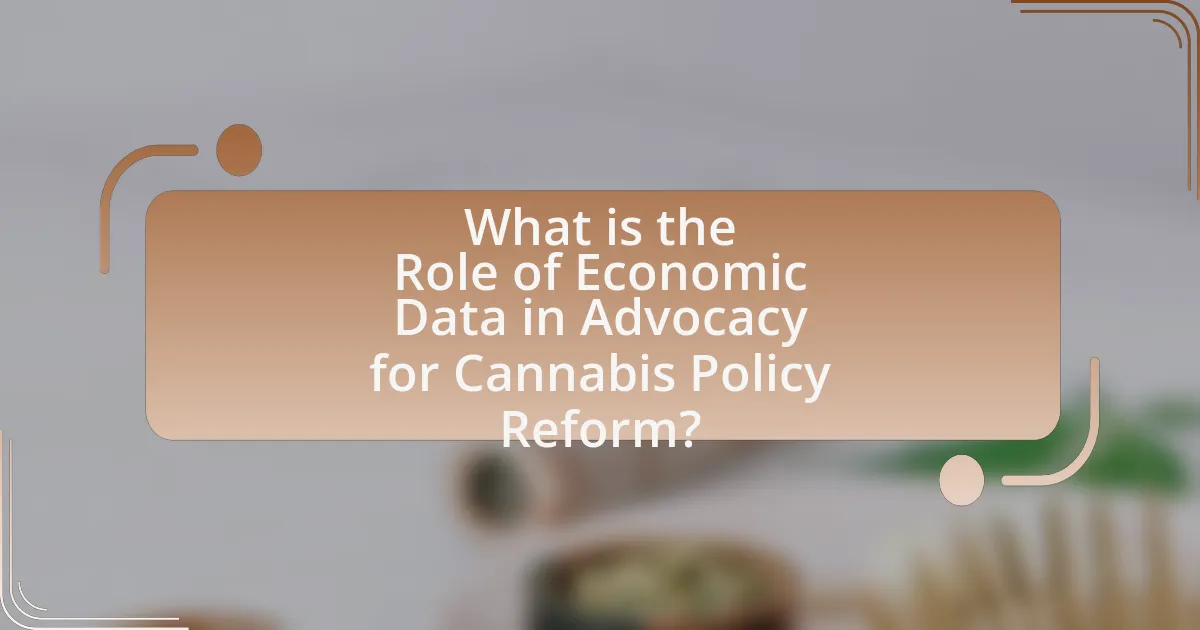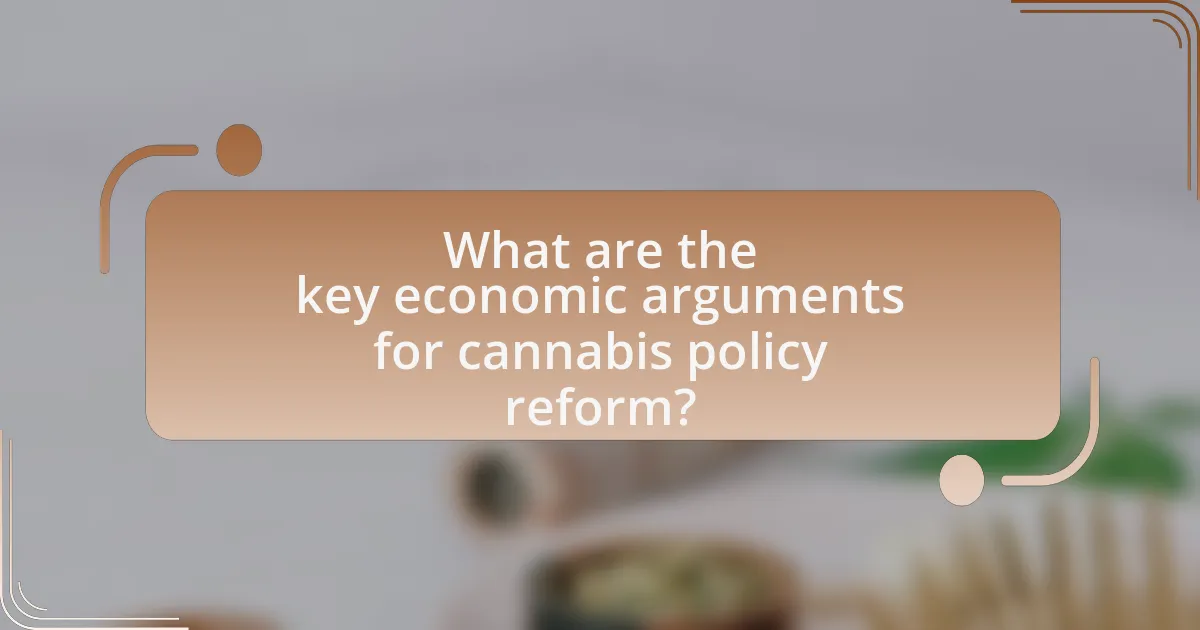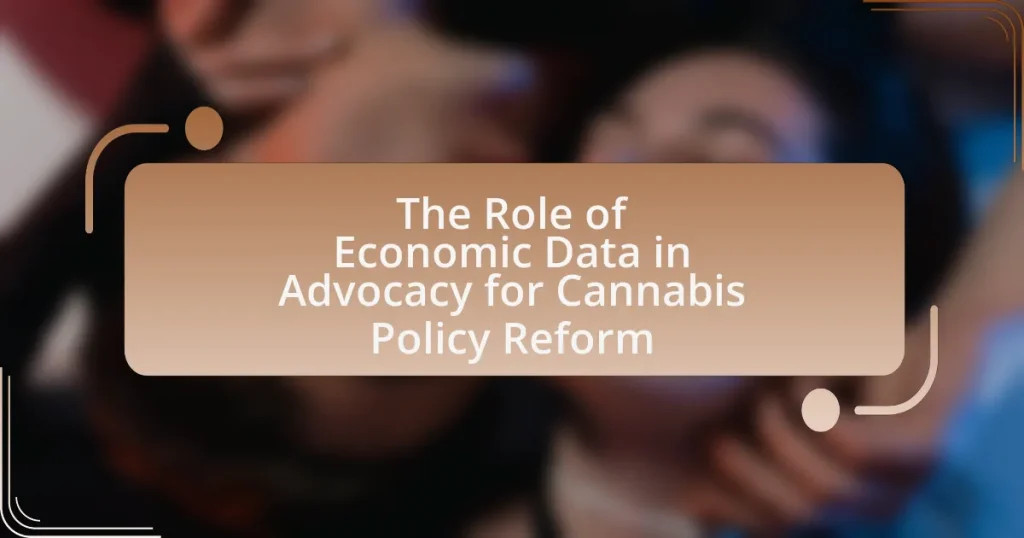The article examines the critical role of economic data in advocating for cannabis policy reform. It highlights how quantifiable evidence, such as tax revenue, job creation, and public health outcomes, can influence policymakers and public opinion. Key economic indicators relevant to cannabis reform, including tax projections and employment statistics, are discussed alongside methods of data collection and analysis. The article also addresses the importance of economic data for advocacy groups, the arguments that can be made using this data, and the impact of legalization on state and local economies. Additionally, it explores strategies for effectively communicating economic findings to stakeholders and the challenges faced in utilizing economic data for advocacy.

What is the Role of Economic Data in Advocacy for Cannabis Policy Reform?
Economic data plays a crucial role in advocating for cannabis policy reform by providing quantifiable evidence of the potential benefits and impacts of legalization. This data includes statistics on tax revenue, job creation, and public health outcomes, which can persuade policymakers and the public of the advantages of reform. For instance, a report from the Marijuana Policy Project indicates that states with legalized cannabis have generated over $10 billion in tax revenue since 2014, demonstrating significant economic benefits. Additionally, studies show that legalization can lead to a decrease in opioid prescriptions, suggesting positive public health implications. Such concrete economic data supports the argument for reform by illustrating tangible benefits, thereby influencing legislative decisions and public opinion.
How does economic data influence cannabis policy decisions?
Economic data significantly influences cannabis policy decisions by providing lawmakers with quantifiable evidence of potential tax revenues, job creation, and economic growth associated with legalization. For instance, states like Colorado and California have reported hundreds of millions in tax revenue from cannabis sales, which has been used to fund public services such as education and healthcare. Additionally, economic studies, such as those conducted by the Marijuana Policy Project, demonstrate that legal cannabis markets can create thousands of jobs, thereby appealing to policymakers focused on employment rates and economic stability. This data-driven approach allows advocates to present compelling arguments for reform, showing that legalization can lead to substantial economic benefits while also addressing public health and safety concerns.
What types of economic data are most relevant to cannabis policy reform?
The types of economic data most relevant to cannabis policy reform include tax revenue projections, employment statistics, market size estimates, and public health cost analyses. Tax revenue projections provide insight into potential financial benefits for governments, as seen in states like Colorado, which generated over $1.7 billion in cannabis tax revenue from 2014 to 2021. Employment statistics highlight job creation in the cannabis industry, with estimates suggesting that legal cannabis could create over 1 million jobs by 2025. Market size estimates indicate the growth potential of the cannabis market, projected to reach $41.5 billion by 2025 in the U.S. Lastly, public health cost analyses assess the economic impact of cannabis legalization on healthcare systems, including potential savings from reduced incarceration rates and decreased opioid prescriptions. These data types collectively inform policymakers about the economic implications of cannabis reform.
How is economic data collected and analyzed in the context of cannabis?
Economic data in the context of cannabis is collected through various methods, including surveys, sales data from dispensaries, tax revenue reports, and market research studies. These data sources provide insights into consumer behavior, market size, and economic impact. For instance, states that have legalized cannabis often report tax revenue figures, which can be analyzed to assess the financial benefits of legalization. Additionally, organizations like New Frontier Data and BDS Analytics conduct comprehensive market research, offering detailed reports on cannabis sales trends and consumer demographics. This data is crucial for advocacy efforts, as it supports arguments for policy reform by demonstrating the economic potential of the cannabis industry.
Why is economic data important for cannabis advocacy groups?
Economic data is crucial for cannabis advocacy groups because it provides evidence to support policy reform efforts. By analyzing economic indicators such as tax revenue from legalized cannabis sales, job creation in the cannabis industry, and the potential savings in law enforcement costs, advocacy groups can present a compelling case to lawmakers and the public. For instance, a report from New Frontier Data indicated that the legal cannabis market could generate over $41 billion in tax revenue by 2025, demonstrating the financial benefits of legalization. This data empowers advocacy groups to argue for the economic advantages of cannabis reform, making their case more persuasive and grounded in factual evidence.
What arguments can be made using economic data to support cannabis reform?
Economic data can support cannabis reform by demonstrating potential tax revenue generation, job creation, and cost savings in law enforcement. For instance, states that have legalized cannabis, such as Colorado, reported over $1.7 billion in tax revenue from cannabis sales since legalization in 2014. Additionally, the cannabis industry has created tens of thousands of jobs; Colorado alone saw an increase of over 30,000 jobs in the sector by 2020. Furthermore, legalizing cannabis can reduce law enforcement costs associated with policing and prosecuting cannabis-related offenses, which can save millions in taxpayer dollars. These economic indicators provide a strong foundation for advocating cannabis reform.
How do economic indicators affect public perception of cannabis policy?
Economic indicators significantly influence public perception of cannabis policy by shaping opinions on its economic viability and social benefits. For instance, data showing increased tax revenue from legalized cannabis markets can enhance public support, as seen in states like Colorado, where cannabis tax revenue exceeded $1 billion by 2021, demonstrating financial benefits. Additionally, indicators such as job creation in the cannabis industry can positively sway public opinion; reports indicate that legal cannabis created over 300,000 jobs in the U.S. by 2021. These economic factors contribute to a perception of cannabis policy as beneficial, reinforcing calls for reform and acceptance.

What are the key economic arguments for cannabis policy reform?
The key economic arguments for cannabis policy reform include increased tax revenue, job creation, and reduced law enforcement costs. Legalizing cannabis can generate significant tax revenue; for example, Colorado collected over $1.7 billion in cannabis tax revenue from 2014 to 2021, which has been allocated to education, healthcare, and infrastructure. Additionally, the cannabis industry has the potential to create thousands of jobs; in 2020, the cannabis sector employed over 321,000 workers in the United States, a number projected to grow as more states legalize. Furthermore, reforming cannabis laws can lead to decreased law enforcement expenditures; states that have legalized cannabis often report savings in policing and incarceration costs, allowing funds to be redirected to other public services. These economic factors collectively support the case for cannabis policy reform.
How does cannabis legalization impact state and local economies?
Cannabis legalization positively impacts state and local economies by generating significant tax revenue and creating jobs. For instance, states like Colorado reported over $1.7 billion in tax revenue from cannabis sales since legalization in 2014, which has been allocated to education, healthcare, and infrastructure. Additionally, the cannabis industry has created thousands of jobs; in California alone, the industry employed over 50,000 workers as of 2021. These economic benefits demonstrate that cannabis legalization can stimulate growth and provide essential funding for public services.
What revenue streams are generated from legalized cannabis?
Legalized cannabis generates multiple revenue streams, primarily through taxation, sales, and ancillary businesses. Tax revenue from cannabis sales can be substantial; for example, in Colorado, cannabis tax revenue reached over $387 million in 2020, contributing to state education and infrastructure funding. Additionally, retail sales of cannabis products create direct revenue for dispensaries and cultivators, with the U.S. cannabis market projected to exceed $41 billion by 2025. Ancillary businesses, such as packaging, security, and consulting services, also benefit financially from the cannabis industry, further diversifying the economic impact of legalization.
How does cannabis reform affect job creation and employment rates?
Cannabis reform positively affects job creation and employment rates by generating new job opportunities in various sectors, including agriculture, retail, and manufacturing. For instance, a report from the Leafly Jobs Report indicated that the legal cannabis industry created over 280,000 jobs in the United States by 2021, demonstrating significant employment growth. Additionally, states that have legalized cannabis often experience a decrease in unemployment rates, as seen in Colorado, where the unemployment rate dropped from 8.4% in 2010 to 2.9% in 2021, partly attributed to the burgeoning cannabis sector. This evidence illustrates that cannabis reform can lead to substantial job creation and improved employment rates.
What are the potential cost savings associated with cannabis reform?
Cannabis reform can lead to significant cost savings primarily through reduced law enforcement expenses and increased tax revenue. For instance, states that have legalized cannabis have reported savings in law enforcement costs associated with arrests and prosecutions for cannabis-related offenses. A study by the American Civil Liberties Union indicated that states could save approximately $3.6 billion annually by eliminating cannabis prohibition. Additionally, legal cannabis markets generate substantial tax revenue; Colorado, for example, collected over $1.5 billion in cannabis tax revenue since legalization in 2014, which can be allocated to public services such as education and healthcare. These financial benefits illustrate the potential for cannabis reform to create economic efficiencies and enhance state budgets.
How can economic data illustrate savings in law enforcement and criminal justice?
Economic data can illustrate savings in law enforcement and criminal justice by quantifying the financial impacts of policy changes, such as cannabis legalization. For instance, studies have shown that states which legalized cannabis experienced significant reductions in law enforcement costs associated with drug-related arrests and prosecutions. A report from the American Civil Liberties Union indicated that states could save up to $1 billion annually by eliminating marijuana arrests. Additionally, economic data can highlight increased tax revenues from cannabis sales, which can be reinvested into community programs and public safety initiatives, further demonstrating the financial benefits of reforming cannabis policies.
What are the healthcare cost implications of cannabis legalization?
Cannabis legalization can lead to significant healthcare cost implications, primarily through reduced expenditures on opioid prescriptions and associated healthcare services. A study published in the Journal of Health Economics found that states with legalized medical cannabis experienced a 25% reduction in opioid prescriptions, which correlates with lower healthcare costs related to opioid addiction treatment and emergency room visits. Additionally, cannabis may serve as a substitute for more expensive pharmaceuticals, potentially lowering overall medication costs for patients. Furthermore, legalization can generate tax revenue that can be allocated to public health initiatives, further offsetting healthcare costs.

How can advocates effectively use economic data in their campaigns?
Advocates can effectively use economic data in their campaigns by presenting clear, relevant statistics that demonstrate the financial benefits of cannabis policy reform. For instance, studies have shown that legalizing cannabis can generate significant tax revenue; Colorado reported over $1 billion in cannabis tax revenue since legalization in 2014. Additionally, advocates can highlight job creation statistics, such as the 18,000 jobs created in the cannabis industry in California alone, to illustrate the economic impact. By utilizing this data, advocates can build a compelling narrative that resonates with policymakers and the public, emphasizing the economic advantages of reforming cannabis laws.
What strategies can be employed to present economic data persuasively?
To present economic data persuasively, one effective strategy is to utilize clear visualizations, such as graphs and charts, which can simplify complex information and highlight key trends. Research indicates that visual aids can enhance understanding and retention of data, making it easier for audiences to grasp the significance of economic arguments. For instance, a study by the American Psychological Association found that people are more likely to remember information presented visually compared to text alone. Additionally, contextualizing data within relatable narratives or case studies can further engage the audience, demonstrating real-world implications of the economic data. This approach not only makes the data more accessible but also reinforces its relevance to the audience’s interests or concerns, particularly in the context of cannabis policy reform.
How can visual data representations enhance advocacy efforts?
Visual data representations enhance advocacy efforts by making complex information more accessible and engaging for diverse audiences. By utilizing charts, graphs, and infographics, advocates can effectively illustrate key economic data related to cannabis policy reform, such as potential tax revenues or job creation statistics. For instance, a study by the Marijuana Policy Project indicates that states with legalized cannabis have generated over $10 billion in tax revenue since 2014, a fact that can be powerfully conveyed through visual means. This clarity not only aids in comprehension but also fosters emotional connections, motivating stakeholders to support policy changes.
What role do case studies play in demonstrating the economic benefits of cannabis reform?
Case studies play a crucial role in demonstrating the economic benefits of cannabis reform by providing real-world examples of financial outcomes following legalization. These case studies illustrate how states that have legalized cannabis have experienced increased tax revenues, job creation, and reduced law enforcement costs. For instance, Colorado reported over $1.5 billion in cannabis tax revenue since legalization in 2014, which has been allocated to education and public health programs. Additionally, a study by the Cato Institute found that legalizing cannabis could save the U.S. government approximately $7.7 billion annually in law enforcement costs. Such concrete evidence from case studies supports the argument for cannabis reform by showcasing tangible economic advantages.
What are common challenges in using economic data for cannabis advocacy?
Common challenges in using economic data for cannabis advocacy include data availability, data reliability, and the complexity of economic modeling. Data availability is often limited due to the ongoing federal prohibition in many regions, which restricts comprehensive economic studies. Additionally, data reliability can be questioned, as many sources may have biases or may not be peer-reviewed, leading to potential inaccuracies in representing the economic impact of cannabis. The complexity of economic modeling further complicates advocacy efforts, as it requires a deep understanding of various economic indicators and their interrelations, making it difficult for advocates to effectively communicate findings to policymakers and the public.
How can advocates address skepticism regarding economic data?
Advocates can address skepticism regarding economic data by ensuring transparency in data sources and methodologies. By providing clear explanations of how data is collected, analyzed, and interpreted, advocates can build trust with their audience. For instance, citing reputable studies, such as those from the National Bureau of Economic Research, which demonstrate the economic impact of cannabis legalization, can reinforce the credibility of the data presented. Additionally, advocates can engage with critics by addressing specific concerns and providing counter-evidence, thereby fostering a more informed dialogue around the economic implications of cannabis policy reform.
What are the limitations of economic data in the context of cannabis policy reform?
Economic data in the context of cannabis policy reform has several limitations, primarily due to the lack of comprehensive and standardized data collection methods. Many states and countries have varying regulations and reporting requirements, leading to inconsistencies in data quality and comparability. For instance, the absence of federal legalization in the United States means that cannabis businesses often operate in a cash-only environment, complicating accurate financial reporting and tax assessments. Additionally, economic models may not fully capture the social and health impacts of cannabis legalization, as they often focus solely on revenue generation and employment figures without considering broader societal implications. Furthermore, existing economic data may be influenced by biases or assumptions that do not reflect the realities of the cannabis market, such as underreporting of illicit sales or overestimating tax revenues. These limitations hinder policymakers’ ability to make informed decisions based on reliable economic evidence.
What best practices should advocates follow when utilizing economic data?
Advocates should ensure the accuracy and relevance of economic data by sourcing it from credible institutions and peer-reviewed studies. Utilizing data from reputable sources, such as government reports or academic research, enhances the reliability of the information presented. For instance, the National Bureau of Economic Research provides extensive data on economic impacts, which can substantiate claims regarding the financial benefits of cannabis policy reform. Additionally, advocates should contextualize the data by comparing it to similar industries or historical trends, thereby illustrating potential outcomes effectively. This approach not only strengthens arguments but also fosters trust among stakeholders and policymakers.
How can advocates ensure the accuracy and reliability of their data sources?
Advocates can ensure the accuracy and reliability of their data sources by employing a systematic approach that includes verifying the credibility of the source, cross-referencing data with multiple reputable sources, and utilizing peer-reviewed research. For instance, data from government agencies, academic institutions, and established non-profit organizations typically undergo rigorous validation processes, making them more reliable. Additionally, advocates should assess the methodology used in studies to ensure that the data collection and analysis are sound, as evidenced by the standards set by organizations like the American Statistical Association, which emphasizes transparency and reproducibility in research. By adhering to these practices, advocates can substantiate their claims with credible evidence, thereby enhancing the effectiveness of their advocacy efforts in cannabis policy reform.
What are effective ways to communicate economic findings to policymakers and the public?
Effective ways to communicate economic findings to policymakers and the public include using clear, concise language, visual aids, and tailored messaging. Clear language ensures that complex economic concepts are easily understood, while visual aids like graphs and charts can illustrate trends and data points effectively. Tailoring messages to specific audiences, such as emphasizing job creation for policymakers or tax revenue for the public, enhances relevance and engagement. Research indicates that policymakers respond better to data presented in actionable formats, such as policy briefs or executive summaries, which highlight key findings and implications. For instance, a study by the Brookings Institution found that visual representations of economic data significantly improve comprehension and retention among non-expert audiences.


